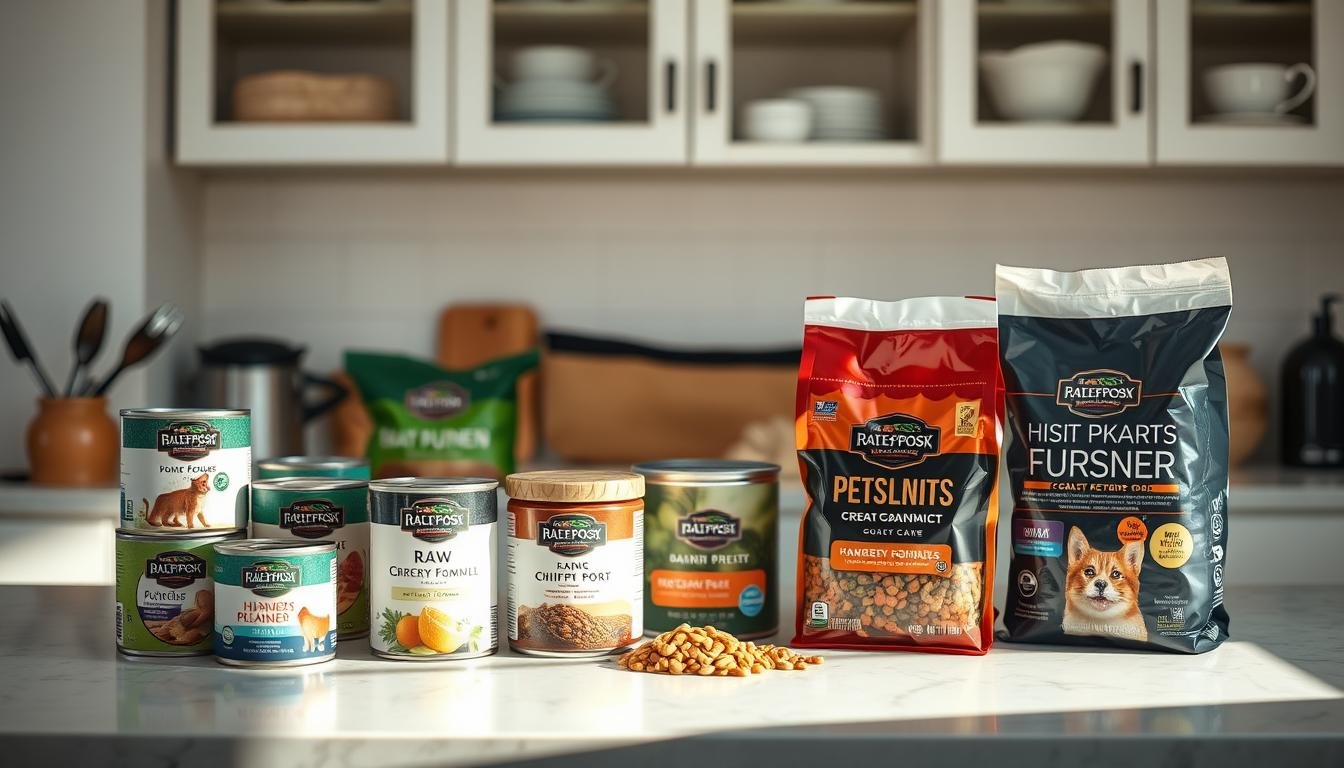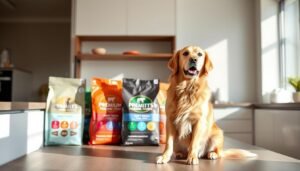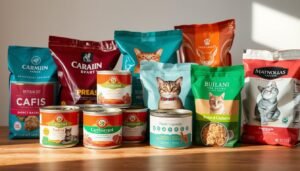When I brought my dog home, I felt so many emotions. I was excited, joyful, and a little unsure. Choosing the right food for her seemed simple at first. But soon, I saw how important it was for her health.
I started looking at different pet foods. I had to understand the labels and ingredients. It was confusing, but I learned a lot. I found out that not all pet foods are the same.
Just like us, pets need food that’s good for them. I tried different foods and learned what works best. I found some of the best pet food brands out there. I want to share what I learned with you.
Let’s find the best food for your pet together. This will make them happy and healthy.
Key Takeaways
- Understanding your pet’s unique nutritional needs is key.
- Quality ingredients are very important when picking pet food.
- Not all foods are right for every life stage; adjust as needed.
- Reading pet food labels helps you make good choices.
- Always talk to your vet before changing your pet’s diet.
- Homemade pet food can be good if you do your research.
- Keep up with recalls to keep your pet safe.
Understanding Your Pet’s Nutritional Needs
Choosing the right pet food starts with knowing what your pet needs. Every pet is different. This helps you pick the best mix of vitamins and nutrients for them.
Different Needs for Different Species
Cats and dogs need different foods. Cats need taurine, but dogs don’t. The right food ensures they stay healthy.
Life Stage Considerations
The age of your pet matters when picking food. Puppies and kittens need lots of nutrients for growth. Adult pets need food that matches their energy and health.
Special Health Requirements
Some pets need special diets. Pets with allergies or weight issues need certain foods. A vet can help find the right food for them.
Reading Pet Food Labels Like a Pro
It’s key to understand pet food labels to pick the best for my pets. I start by looking at the ingredients list. Top brands list real meat first, showing it’s full of protein for growth and health.
I avoid fillers like corn and soy. They lower the food’s nutritional value.
Decoding Ingredients Lists
The ingredients list reveals a lot about the food’s quality. For organic food, I look for brands with whole foods first. This means the food is packed with nutrients.
Some ingredients are good, but not as good as whole foods. It’s important to know the difference.
Understanding Nutritional AAFCO Guidelines
Learning about AAFCO guidelines makes me feel good about my pet’s food. Foods labeled “complete and balanced” meet AAFCO’s standards. This is key for all life stages, like growth and pregnancy.
This ensures my pet gets food that’s not just tasty but also healthy for the long run.
The Importance of High-Quality Ingredients
Choosing the right pet food is key to your pet’s health and happiness. Natural pet food has real meats, veggies, and fruits. These give your pet the nutrients they need to stay well.
On the other hand, meat by-products don’t have as much good stuff. They can even make your pet sick over time.
Whole Foods vs. Meat By-products
Whole foods are full of vitamins and minerals. They help your pet grow strong and have lots of energy. When picking out pet food, I look for brands that list real ingredients.
Here’s a simple comparison:
| Ingredient Type | Nutritional Benefits | Potential Drawbacks |
|---|---|---|
| Whole Foods | Rich in nutrients, easily digestible, supports overall health | Can be more expensive |
| Meat By-products | May contain some protein | Lacks essential nutrients, potentially unhealthy |
The Role of Fillers and Additives
Fillers and additives in cheap pet foods can be bad. They don’t add much good and might even hurt your pet. I suggest picking premium pet food without these bad stuff.
This way, your pet gets only the best ingredients. They’ll stay healthy and happy.
Navigating the World of Grain-Free Diets
When looking for food for my pet, grain-free diets are often considered. They are popular for being healthier. But, not every pet needs them. It’s important to think about what’s best for each pet’s health.
Pros and Cons of Grain-Free Options
Grain-free pet food has good and bad points. The good things are:
- It may help with weight control.
- It’s less likely to cause allergies.
- It has more protein for muscles.
The not-so-good things are:
- It can be unbalanced if not made right.
- It costs more than regular food.
- It might not make every pet healthier.
Common Misconceptions
Many people think grain-free diets are always better. But, that’s not true for everyone. It’s more about the quality of the food than just the lack of grains. Always talk to a vet before switching your pet’s diet.
Evaluating Pet Food Brands
Choosing the right pet food is a big job. I look for brands that care about quality. I want to see if they have good nutritionists and are open about how they make their food.
This helps me pick the best food for my pet.
What to Look for in a Brand
When I look for top pet food, I check if the brand has expert nutritionists. This means the food is good for pets. I also look for clear labels that tell me what’s in the food.
Good brands are open about how they make their food. This makes choosing easier.
Popular Brands with a Good Reputation
Open Farm and Wellness are two brands I trust. They use good ingredients and make food that’s full of nutrients. This is important for my pet’s health.
The Importance of Transparency
Brands that are open build trust. When they tell us about their food, it helps us choose better. Knowing where the ingredients come from is key.
This openness is what makes a brand stand out when we’re looking for the best food.
Understanding Pet Food Recalls
Keeping my pet healthy is very important. Knowing about pet food recalls helps a lot. It stops health problems from bad food. I check the FDA and news sites often to keep my pet safe.
How to Stay Informed About Recalls
Here are some ways to keep up with pet food recalls:
- Visit the FDA website for announcements on recalls and alerts.
- Sign up for alerts from trusted pet nutrition websites.
- Follow reliable pet food brands on social media for real-time updates.
- Check newsletters from vet clinics to receive updates on vet recommended pet food.
What to Do if Your Pet’s Food is Recalled
When I hear about a recall, I act fast. Here’s what I do:
- Check if my pet’s food is on the recall list by looking at product codes and dates.
- Stop using the recalled food right away.
- Watch my pet for any sickness or bad reactions.
- Talk to my vet if my pet gets sick.
Keeping a record of my pet’s food helps with vet talks. It’s key to pick healthy food for my pet’s health.
Considering Homemade Pet Food
I always look for the best for my pets. Homemade pet food is a great choice. It lets me pick the best ingredients for them. This way, I can make sure they get only the best.
It also helps me bond with my pets. I can make their meals special just for them.
Benefits of Making Your Own Pet Food
There are many good reasons to make your own pet food:
- Control over Ingredients: I choose the best, organic food for them. No bad stuff.
- Customization: I can make meals just right for my pets. It’s all about what they like and need.
- Freshness: Fresh ingredients mean my pets get the nutrients they need.
- Cost-Effectiveness: Making food at home can save money. It’s cheaper than buying it.
Essential Ingredients for Home-Cooked Meals
For homemade pet food, I use key ingredients:
| Ingredient | Function |
|---|---|
| High-Quality Protein | Important for muscle growth and repair. Chicken, beef, or fish are good choices. |
| Whole Grains | Grains give energy and fiber. Brown rice or quinoa are good options. |
| Vegetables | Vegetables add vitamins, minerals, and antioxidants. Carrots, peas, and spinach are great. |
| Vitamins and Minerals | These keep pets healthy. Sometimes, I add them in supplement form. |
Talking to a vet or pet nutritionist is key. They help make sure my recipes are right for my pets. This shows how much I care about their health.
Consulting with a Veterinarian
Talking to a vet is key for picking the right food for your pet. They know what’s best for your pet’s health, age, and breed. This helps pick food that keeps your pet happy and healthy.
Why Professional Guidance is Important
Getting advice from a vet is very important for your pet’s food. They can tell you about different foods and what’s good for your pet. If your pet can’t eat certain foods, your vet can help pick the right ones.
Questions to Ask Your Vet
Before changing your pet’s food, make a list of questions. Here are some:
- What nutrients are most important for my pet?
- Do you recommend any food brands?
- How do I switch my pet to new food safely?
- What signs should I look for when trying new food?
You can also use PetDiets for expert advice. They help make special diets for your pet’s needs.
The Role of Personal Experience in Choosing Pet Food
Choosing the right food for my pet is very important. I learn a lot from others who have pets. This helps me pick the best food for my pet’s needs.
What Works for My Pet
Every pet is different. I watch how my pet reacts to different foods. I look for vet recommended pet food to keep them healthy.
Learning from Other Pet Owners
Talking to other pet owners is very helpful. We share tips on healthy food. This helps me find the best food for my pet.
Many of us care about our pets’ food as much as our own. Research shows 53.1% of us want healthy food for our pets. Sharing tips helps us all learn more about pet nutrition. For more info, check out this source.
Tips for Transitioning to New Pet Food
Switching my pet’s food was a big step. I learned to do it slowly to avoid upset stomachs. I started by adding a little new food to their old food.
Over seven to ten days, I slowly added more new food. This made the change easier for both of us.
How to Make the Switch Smoothly
I watched my pet closely for any signs of trouble. Issues like upset stomachs or skin problems were red flags. If I saw any, I went back to the old food and asked a vet for help.
Remember, a vet’s advice on food can be very important. It might be just what your pet needs for health.
Monitoring for Allergies and Reactions
Watching how my pet reacted to the new food was key. It helped me know if I was making the right choice. This careful watching helped my pet eat well and feel happy.
A smooth transition is important for your pet’s health. It makes their life better and keeps them happy. Enjoy the journey and take it one step at a time!





















